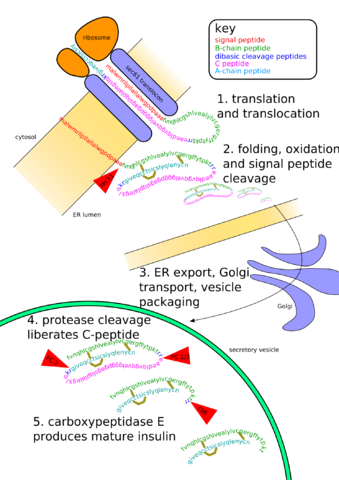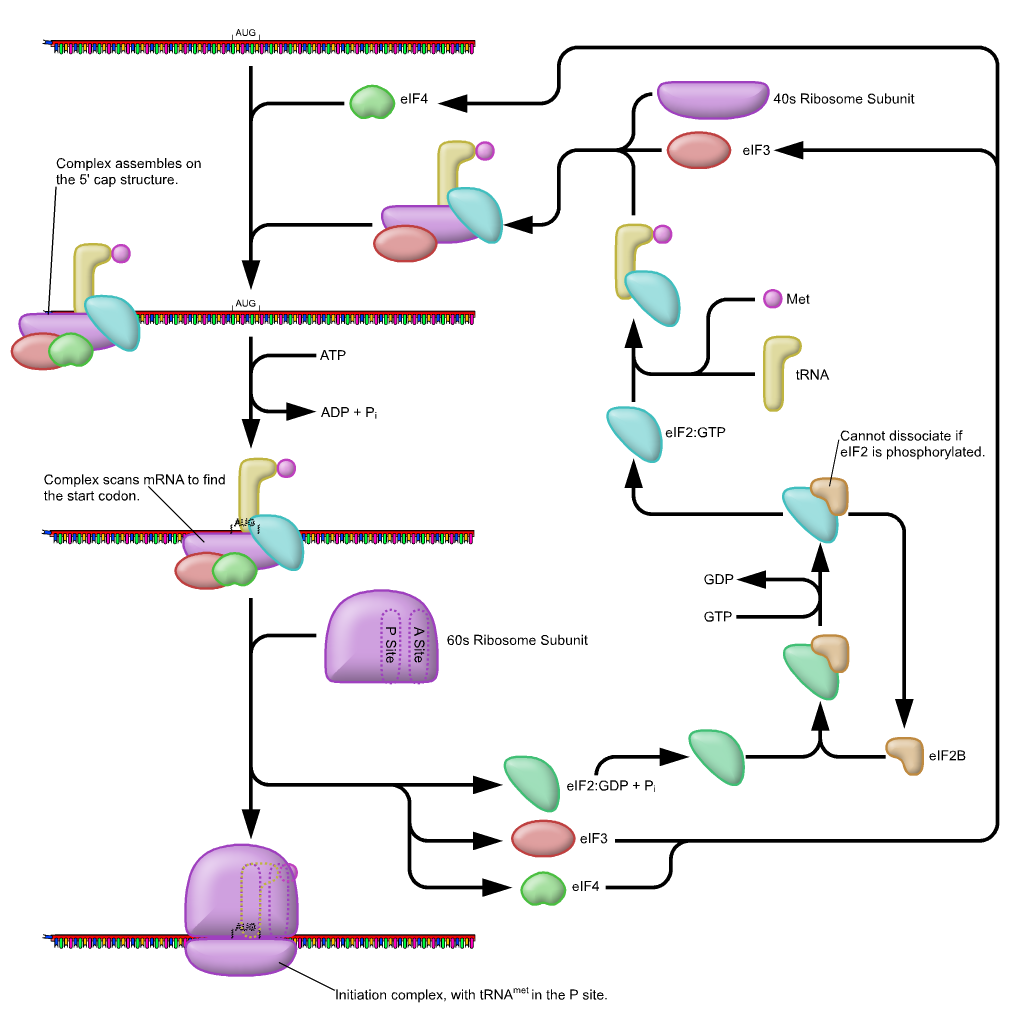 Daily Newsletter
Daily Newsletter
September 12, 2013 - Translation
The core concept of translation is the connecting of a codon to an amino acid. As we saw yesterday, this is accomplished with the Transfer RNAs. What that leaves us with then is the actual mechanism of amino acid polymerization.
Initiation of Translation
Protein function is determined by the sequence of amino acids. This sequence allows the protein to fold into the correct configuration to produce activity. Any variation in the sequence can produce alterations to function, or even result in non-functionality. In order to generate the correct sequence, we must first establish the correct reading frame of codons. We must first find the start codon on mRNA.The small subunit of the Ribosome (40s in eukaryotes) is built to find the Start Codon (AUG) and will align the full ribosome with the correct reading frame. A number of proteins will help the alignment, and in the formation of the full (holozyme) Ribosome.
The diagram below shows the overall formation of the initiation complex, complete with a tRNA (the yellow structure with a pink circle attached). Again, the function of this replication complex is to find the start codon and set the reading frame for the Ribosome. Notice that the large ribosomal subunit (60s in eukaryotes) only attaches after AUG has been found. As before, it is not neccesary at this academic level to memorize all of the factors involved. What is more critical is that it is a multifactor system designed to find the correct start point, and thus the same reading frame.
Key Feature: Notice that the first tRNA is already linked to the small subunit. Why? It's anticodon is complimentary to the a codon on mRNA. Specifically it has the anticodon for the start codon (AUG). So we are using base complementarity to find AUG.
Elongation
The polymerization of amino acids occurs during elongation. This is where the P and A sites become important (NOTE: P and A sites are the active sites of the enzyme). P stands for Peptidyl, while A stands for Aminoacyl. These are chemical terms,which shows the orientation of the amino acid. The exit site, represented by E, is not an active site. Consider it a disposal point for spent tRNAs. [NOTE: you may also find references to a fourth site where the tRNA first comes into the comples. Don't worry about this optional site.]The P and A sites reveal a single codon on mRNA, and can hold a single complimentary tRNA. During elongation, when you have a filled P and A site, the amino acid from the P site will be linked to the amino acid in the A site. This is a process that you will have to visualize, so use the diagram below as reference:
The amino end of the amino acid is free. The carboxyl end is attached to the tRNA. Starting at the top of the above diagram, the growing amino acid chain is attached to a tRNA in the P site. A new tRNA with an aminom acid (charged tRNA) is brought into the A site. Using GTP, the Ribosome (large subunit) takes the growing peptide chain and links (carboxyl to amino) it to the individual amino acid in the A site. When this is done, the entire ribosome shifts downstream to the next codon (the new codon appears in the A site).
The spent tRNA that started in the P site is now moved to the E site, where it is removed from the ribosome. NOTE: It takes 2 GTP to create the peptide bond, then another GTP to move the ribosome. So a total of 3 GTP are used in one 'round' of Ribosomal action. REMEMBER THIS! In addition, it took a triphosphate to charge tRNA (so a total of 4 for each amino acid added to the polymer).
When both the P and A sites have charged tRNA, the growing chain from the P site is added to the single amino acid in the A site. The ribosome shifts, and the process continues. This elongation process of adding amino acids (amino acid polymerization) will continue until a STOP codon is reached (UAA, UAG and UGA).
Question: How much ATP will you need to expend to make a protein with 100 amino acids? How about a 150 amino acid protein? GOAL: Recognize and be able to articulate why protein synthesis is an energy consumptive process, and be able to discuss why it is critical for cells to regulate energy consumptive processes.
Termination
To create a functional protein, translation must end with the appropriate amino acid. If translation stops to soon, the protein will be to short and many not bend (configure) correctly. If it is too long, then it may not bend (configure) correctly. Termination is a critical process. Termination begins when a STOP CODON (UAA, UAG and UGA) is reached. In eukaryotes, a releasing factor is used to seperate the ribosomal subunits. KEY CONCEPT: The stop codon signals the end of the coded message.Additional Information
The following is just a little additional information about transcription. This "special topic" is not going to be used for tests/exams, but we will see this material again before the end of the semester. Once completed, proteins can be further modifed as fits their function (such as adding sugars). This is known as post-translational modification. The image below shows the posttranslational modifications needed in the production of insulin. Production starts with a ribosome bound on the Rough Endoplasmic Reticulum (RER). Processing will occur in the RER and in the Golig body. This is only one example of posttranscriptional modification, and a majority of proteins require such modifications before they are functional. [NOTE: as a general rule, there is less extensive posttranscriptional modification in prokaryotes, but they have numerous proteins that do require modification].
Daily Challenge
Proteins provide the cell with various functions, from channels that allow the passage of ions to enzymes that govern catabolic processes. In translation, a sequence of nucleic acids is translated into a sequence of amino acids. The ribosome is central to the process of translation, and though the size and complexity vary between domains (archaea, bacteria, eukarya), it works basically the same.Reflect on the universality of the genetic code and the ubiquitous ribosome. SNPs were mentioned yesterday; what would happen if you altered the sequence of amino acids in Ribosomal proteins? What would happen if you altered the sequence of nucleotides in Ribosomal RNA (rRNA)? Really consider how vital the process of translation is to the life of a cell. The only time we slow down making proteins when during cellular division (even then we don't stop making proteins).
Write a description of the process of translation, and include your insights into this vital metabolic activity.
Link to Forum
Special Challenge: Genomics and Proteomics
Read the following articles:A brief guide to genomics - NIH fact sheet
Transcriptome - NIH fact sheet
Proteomics
The genome can be seen as the genetic potential of an individual (think Genotype), while the proteome shows what is actually produced at a given time, under a given condition (consider this the phenotype). Provide a discussion of the importance of genomic and proteomic studies in modern biological resarch, and make sure that you provide a description of both the geneome and the proteome of an organism.
Link to Forum



No comments:
Post a Comment